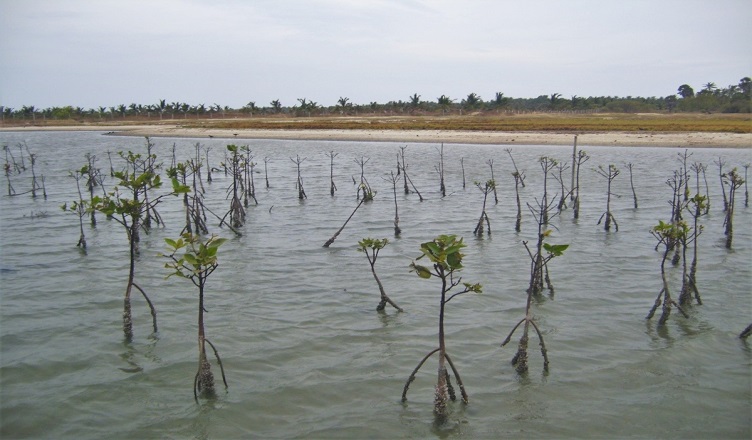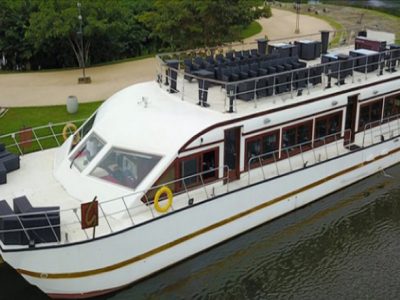(LANKAPUVATH | COLOMBO) – Mangrove forests play critical roles in Sri Lanka’s economy and climate resilience but are rapidly degrading due to climate change and pollution. A large-scale initiative to increase mangrove cover across Sri Lanka by more than 50 per cent was today named as one of seven UN World Restoration Flagships.
The World Restoration Flagship awards are part of the UN Decade on Ecosystem Restoration – led by the UN Environment Programme (UNEP) and the Food and Agriculture Organization of the UN (FAO) – which aims to prevent, halt, and reverse the degradation of ecosystems on every continent and in every ocean. The awards track notable initiatives following global commitments to restore one billion hectares – an area larger than China.
Mangrove forests thrive along the border between land and sea and are the first line of defence for coastlines, reducing erosion from storm surges, currents, waves, and tides. Their intricate root system makes them attractive to fish and other organisms seeking nurseries, food, and shelter. This need for the ecosystem’s mitigating effect was dramatically stressed during the 2004 tsunami, which killed more than 30,000 people in Sri Lanka. The award for the Sri Lanka Mangrove Regeneration initiative was announced by UNEP Advocate for Life Under Water and actor, Jason Momoa.
Following the tsunami, Sri Lanka led a mass-drive to plant mangroves. However, noticing that only approximately three per cent of the planted saplings survived, the country changed tactics: from planting mangroves to nurturing them. By creating the right conditions for mangroves to thrive, the plants started regenerating naturally. Ecosystem restoration on the island is now science-driven, co-led by local communities, and focused on restoring the natural balance in the ecosystem. Thanks to the country’s partnership with the Australian and UK governments, the focus on ensuring growth has already resulted in 500 hectares of newly restored mangroves since the initiative was founded in 2015.
Today, this resilient and biodiverse ecosystem provides natural protection against climate change – including cyclones, floods, sea level rise, wave action and coastal erosion –as well as medicine, fish, and other food, especially in poorer communities.
“As an island nation, mangroves are the first line of defence for us. Investing in restoration is investing in well-being, societal health and economic prosperity of Sri Lanka. It is also our contribution to global priorities and our deep understanding nurtured by living with nature, that all living beings, not just humans, share this wonderful ecosystem,” said Mr. B.K Prabath Chandrakeerthi, Secretary, Ministry of Environment of Sri Lanka.
In 2015, Sri Lanka became the first nation to legally protect all its mangrove forests and established the National Expert Committee on Mangrove Conservation and Sustainable Use, spurring several actions to protect and manage mangroves including new declarations under the legislations.
In 2020, the Government of Sri Lanka adopted a National Policy on Conservation and Sustainable Utilization of Mangrove Ecosystems in Sri Lanka. To maintain the sustainability of the policy, the “National Strategic Action Plan for Conservation and Sustainable Utilization of Mangroves in Sri Lanka” was developed in 2022, complemented by National Guidelines. In 2022, the UN General Assembly adopted a resolution sponsored by Sri Lanka to celebrate 1st of March as World Seagrass Day. Seagrasses are closely linked to mangroves and the health of the overall ocean ecosystem.
Recognised as a World Restoration Flagship, Sri Lanka’s mangrove restoration drive is now eligible for technical and financial UN support. This will bring it closer to realize its 2030 goal of restoring 10,000 hectares of mangroves – more than 50 per cent of the country’s mangrove cover – benefiting 5,000 households and creating over 4,000 new jobs.
“Mangroves are one of the planet’s most productive ecosystems. Sri Lanka’s unwavering commitment to their restoration is one of the best possible bargains to be made with nature,” said Inger Andersen, Executive Director of UNEP. “The country’s relentless work on perfecting the planting of mangroves shows how restoration must be a long-term investment. Sri Lanka’s experience is one which many other nations would do well to draw from.”
Sri Lanka expects to be able to achieve its restoration 2030 goals with additional funding of USD 3.5 million to support livelihood activities, maintain restoration sites and restore channels r, as well as cleaning and boundary management, awareness raising and calculation of the value of carbon sequestered by the restoration of mangroves.
As a World Restoration Flagship, Sri Lanka’s mangrove restoration is recognized as one of the best examples of large-scale and long-term ecosystem restoration in any country or region, embodying the 10 Restoration Principles of the UN Decade on Ecosystem Restoration. The announcement of seven new World Restoration Flagships was made ahead of the 6th UN Environment Assembly (UNEA-6), held between February 26 and March 1, 2024. The Assembly will convene the world’s Environment Ministers in Nairobi, Kenya, to address the triple planetary crisis of climate change, nature and biodiversity loss, and pollution and waste.
(decadeonrestoration.org)




